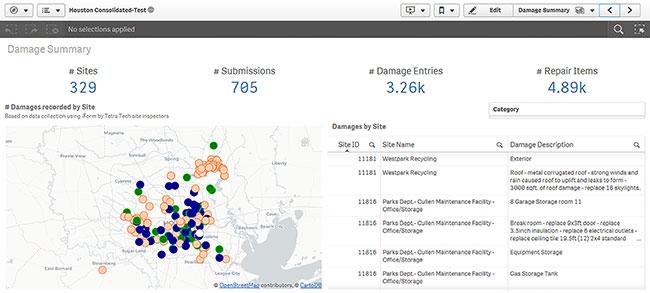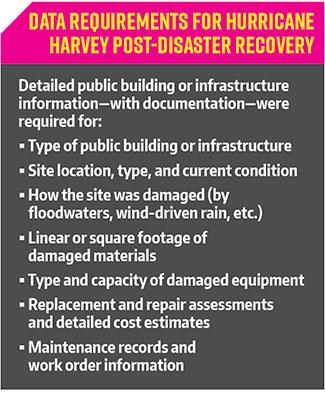Driving Decisions With Data Dashboards: Helping Houston Recover From Hurricane Harvey
Harnessing the power of data throughout the project life cycle
Driving Decisions with Data Dashboards
Across Tetra Tech’s markets, nearly all clients share the need for actionable information that can drive decision making. Big data began bursting onto the scene some 25 years ago, inundating our information-hungry clients with megabytes and gigabytes of facts and figures that soon became a flood of petabytes and zettabytes. Managers thirsty for relevant intelligence were drowning in oceans of data, wondering what was important, what was essential, and what was urgent information.
In response to the need for timely and relevant information that can be analyzed, Tetra Tech employees from many facets of engineering, science, and technology began to apply methodologies to identify, analyze, and report mission-critical information. This article explores some of the ways we are Leading with Science® by using innovative data analytics techniques and digital dashboards—tools that integrate, display, and analyze key data—to help our clients gain insights that allow them to improve customer service and efficiency, make decisions in real time, and even use predictive analytics to steer toward the best future outcome.
Helping Houston recover from Hurricane Harvey
Information is a critical ally when you are supporting a major city get back on its feet. When Hurricane Harvey first reached the Texas coast in August 2017, no one foresaw how long it would stay or how wet it would be. After a week of epic rainfall that eclipsed prior storm totals—from 3 to 4 feet or more in some places—Harvey went into the record books as one of the Gulf Coast’s most destructive and unwelcome guests. Ever.
As the flood waters subsided in early September, local officials began to take stock of their saturated cities. Houston was hit hard, with flooded streets and neighborhoods, along with the many facilities in downtown. In some areas, the water took weeks to recede, resulting in a slow-motion cleanup saga that had residents creating 10-foot-tall piles of debris from their flooded homes—drywall, flooring, furniture, cabinets, and carpet—along the flooded streets of the city.
Tetra Tech’s Houston office had worked with the City in earlier flood events and was immediately requested to help organize, manage, and report on the massive debris removal effort. The task was formidable: State officials estimated that nearly 20 million cubic yards of debris needed to be managed across Texas, with more than one-third of that volume originating in Houston and the rest of Harris County.
As Tetra Tech tackled the debris challenge, the extent of Houston’s support needs became clear. Data collection work was extensive—scheduling reports, truck dispatches, labor hours, equipment rental costs, and tracking debris volume, type, storage, and destination (e.g., landfill or recycling center). In addition, the City needed detailed information to recover the disaster response costs. Tetra Tech Disaster Recovery (TDR) employees Ralph Natale, Jeffrey Dickerson, and Donald Kunish set up the initial data management tools using a combination of a customized and tablet-based field reporting app, RecoveryTracTM, Esri ArcGIS, Microsoft (MS) SharePoint, and MS Access based on their work at previous disasters.
The tools were adequate for early data collection efforts related to immediate disaster response, but Tetra Tech staff saw the opportunity to add an integrated platform that could support more sophisticated data management to support long-term disaster recovery.
The Federal Emergency Management Agency (FEMA) requires highly granular data to support grant application and reimbursement. To support that requirement, the Tetra Tech team needed to incrementally implement an integrated and comprehensive data collection, management, and reporting system by expanding and linking existing tools to a broader and more robust platform. Tetra Tech’s Federal Information Technology (FIT) and TDR groups collaborated on identifying ways to implement a solution to provide improved efficiencies and greater capabilities while minimizing disruption of ongoing efforts.
The result is a networked and highly functional framework for collecting, managing, and using the flood of incoming data to visualize the progress of damage inventory collection and recovery using real-time dashboards. Drill-down features into the data allow the review of detailed cost estimates for repairs to existing buildings and facilities. The dashboards also are being used to download and analyze the data for the development of mitigation strategies that will reduce the risk of future loss, as well as scopes of work for the City to use in completing repairs.
The data are enabling Tetra Tech’s hazard mitigation and flood protection experts to develop options for the City, both at small and larger scales. The City expects to receive approximately $2 billion from FEMA for repairs to public buildings and infrastructure. The City’s goal is to leverage some of these funds to rebuild a more resilient, sustainable Houston that provides more benefits to residents. Our experts are helping City leaders make data-driven decisions to reach their goals.
The volume of data generated in our industry grows every day. Our challenge is to sift through vast data sets, identify critical information needed to make meaningful decisions, and present that information in a simplified, usable format. Throughout its markets—from disaster recovery to water, environment, energy, aviation, and beyond—Tetra Tech helps clients harness the power of their data to boost success throughout project life cycles.



